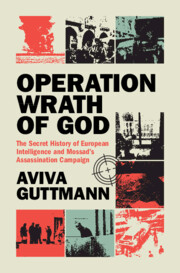Refine search
Actions for selected content:
501 results
5 - Episodes in Rival Narratives
-
- Book:
- The Narrative Conflict of Traditions in the Late Antique World
- Published online:
- 22 September 2025
- Print publication:
- 09 October 2025, pp 158-197
-
- Chapter
- Export citation
The Notion of an Illegal Occupation in the ICJ’s Palestine Advisory Opinion
-
- Journal:
- International & Comparative Law Quarterly , First View
- Published online by Cambridge University Press:
- 08 September 2025, pp. 1-37
-
- Article
-
- You have access
- Open access
- HTML
- Export citation
Reflections on our article ‘Postwar development of offshore energy resources: Legal and political models for developing the Gaza Marine gas field’
-
- Journal:
- Leiden Journal of International Law / Volume 38 / Issue 1 / March 2025
- Published online by Cambridge University Press:
- 01 September 2025, pp. 30-39
-
- Article
-
- You have access
- Open access
- HTML
- Export citation

Operation Wrath of God
- The Secret History of European Intelligence and Mossad's Assassination Campaign
-
- Published online:
- 12 August 2025
- Print publication:
- 07 August 2025
Hamas’ October 7th Genocide: Legal Analysis and the Weaponisation of Reverse Accusations – A Study in Modern Genocide Recognition and Denial
-
- Journal:
- Israel Law Review , First View
- Published online by Cambridge University Press:
- 08 August 2025, pp. 1-40
-
- Article
-
- You have access
- Open access
- HTML
- Export citation
7 - A Car Bomb in Paris, a Firing Squad in DC, a Thwarted Attack near Vienna
- from Part II - Europe’s Covert War against the Palestinian Armed Struggle
-
- Book:
- Operation Wrath of God
- Published online:
- 12 August 2025
- Print publication:
- 07 August 2025, pp 177-206
-
- Chapter
- Export citation
Introduction: Intelligence that Kills
-
- Book:
- Operation Wrath of God
- Published online:
- 12 August 2025
- Print publication:
- 07 August 2025, pp 1-14
-
- Chapter
-
- You have access
- HTML
- Export citation
2 - Preparing the Kill List
- from Part I - Preparing for God’s Wrath
-
- Book:
- Operation Wrath of God
- Published online:
- 12 August 2025
- Print publication:
- 07 August 2025, pp 33-50
-
- Chapter
- Export citation
The West Bank as Occupied Territory: The Irrelevance of the Mandate and the Lack of Jordanian Sovereignty
-
- Journal:
- Israel Law Review , First View
- Published online by Cambridge University Press:
- 07 August 2025, pp. 1-39
-
- Article
-
- You have access
- Open access
- HTML
- Export citation
4 - A Bomb in Paris and Two Attacks in Bangkok and Rome
- from Part II - Europe’s Covert War against the Palestinian Armed Struggle
-
- Book:
- Operation Wrath of God
- Published online:
- 12 August 2025
- Print publication:
- 07 August 2025, pp 85-110
-
- Chapter
- Export citation
Did the ICJ Act Ultra Vires? The Orders on the Convention on the Prevention and Punishment of the Crime of Genocide in the Gaza Strip
-
- Journal:
- Israel Law Review , First View
- Published online by Cambridge University Press:
- 07 August 2025, pp. 1-26
-
- Article
-
- You have access
- Open access
- HTML
- Export citation
1 - Setting the Scene
- from Part I - Preparing for God’s Wrath
-
- Book:
- Operation Wrath of God
- Published online:
- 12 August 2025
- Print publication:
- 07 August 2025, pp 17-32
-
- Chapter
- Export citation
8 - Lillehammer Fiasco: Official Condemnation, Covert Approval
- from Part III - Blunder and Cooperate
-
- Book:
- Operation Wrath of God
- Published online:
- 12 August 2025
- Print publication:
- 07 August 2025, pp 209-235
-
- Chapter
- Export citation
Conclusion: A Secret Security Order
- from Part III - Blunder and Cooperate
-
- Book:
- Operation Wrath of God
- Published online:
- 12 August 2025
- Print publication:
- 07 August 2025, pp 236-255
-
- Chapter
- Export citation
3 - A Firing Squad in Rome and Four Black September Attacks
- from Part II - Europe’s Covert War against the Palestinian Armed Struggle
-
- Book:
- Operation Wrath of God
- Published online:
- 12 August 2025
- Print publication:
- 07 August 2025, pp 53-84
-
- Chapter
- Export citation
6 - A ‘Battle of the Spooks’ in Paris, Beirut, Nicosia, and Rome
- from Part II - Europe’s Covert War against the Palestinian Armed Struggle
-
- Book:
- Operation Wrath of God
- Published online:
- 12 August 2025
- Print publication:
- 07 August 2025, pp 148-176
-
- Chapter
- Export citation
Introduction
-
- Book:
- Occupier and Occupied
- Published online:
- 15 June 2025
- Print publication:
- 26 June 2025, pp 1-33
-
- Chapter
- Export citation
Conclusion
-
- Book:
- Occupier and Occupied
- Published online:
- 15 June 2025
- Print publication:
- 26 June 2025, pp 144-151
-
- Chapter
- Export citation
3 - ‘Injured Soldiers’, ‘Just Warriors’, or ‘Monsters’: Emotionality, ‘Morality’, and Militarised Masculinities in Israel
-
- Book:
- Occupier and Occupied
- Published online:
- 15 June 2025
- Print publication:
- 26 June 2025, pp 75-93
-
- Chapter
- Export citation
1 - The Docile Bodies of ‘Muscular Judaism’: Militarised Masculinities and Embodied Compliance in Israel
-
- Book:
- Occupier and Occupied
- Published online:
- 15 June 2025
- Print publication:
- 26 June 2025, pp 34-55
-
- Chapter
- Export citation
